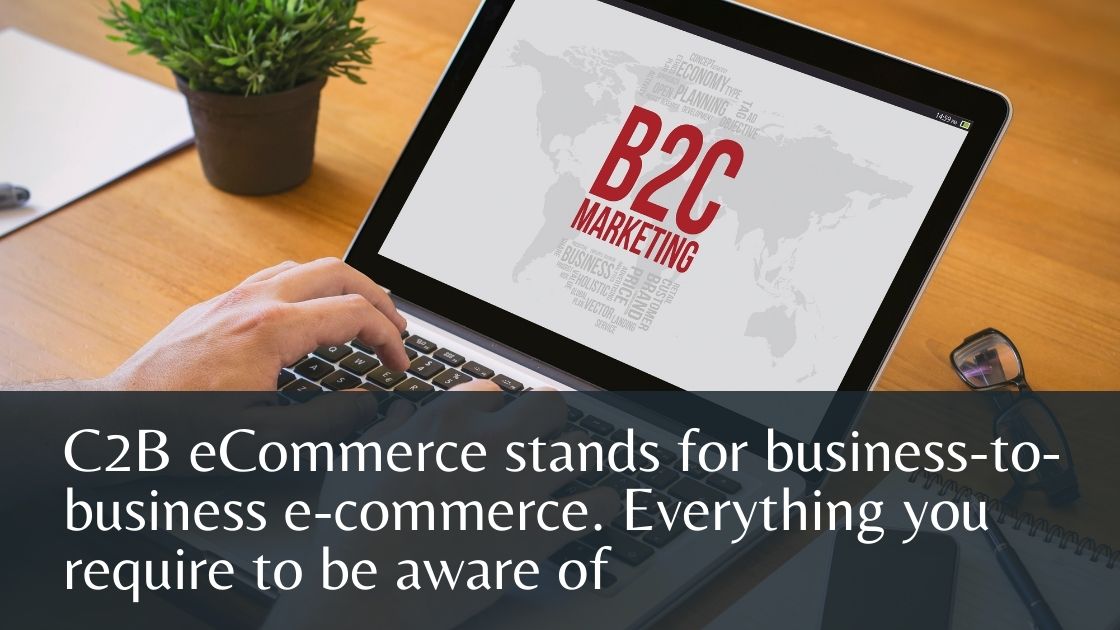C2B eCommerce, a popularly growing eCommerce business type, has yet to gain traction with the general public.

C2B eCommerce-The consumer to business (C2B) model, unlike most traditional business models, allows enterprises to benefit from their customers and vice versa.
Customers’ willingness to provide marketing advice or data to the business or quote their own rates is rewarded in this business structure.
Consumers benefit from direct payments, flexibility, lower costs, or free products and services in the same way.
“The primary element of C2B is that clients bring value to the business,” says Brent Walk, vice president of C2B solutions. Clients can collaborate with a company on product/service concepts, solutions, and ideas via social media or other means.
\
How to start and manage your own youtube channel
Trends in B2B eCommerce
The C2B system is the polar opposite of the standard one. End-users create services and goods that are consumed by the organisations and enterprises from which they purchase.
In other cases, rather than a firm advertising a product or service to potential customers, people now demand a product or service at a specific price point that they are satisfied with and wait for the business to fill the gap.
Because of the power of the internet, this form of eCommerce strategy is becoming increasingly prevalent. Clients are beginning to recognise their power and are using it to negotiate better bargains. Upwork is a fantastic example.
It was one of the first sites to implement the C2B concept, in which individuals may advertise services and interested businesses can respond with bids.
Hacking your Web browser in 2 easy steps
What is the mechanism behind it?

Because of simple access to a large number of loyal clients, the consumer to company model has functioned very well online.
This new bi-directional structure has allowed clients to become their own entities in circumstances when business transactions were mostly directional, with enterprises pushing items and services to customers.
Furthermore, lower costs for web development, high-quality printers, and video cameras allow clients immediate access to communication and promotion tools that were previously only available to large international corporations. As a result, the C2B business system benefits both enterprises and consumers.
However, in order for a C2B model to be fully realised, the parties must be clearly specified. A customer can be someone who has anything important to give a business, whether it’s a product or a service—for example, a photographer or blogger who sells stock photographs to businesses.
Customers can also answer survey questions on a survey website or recommend people to referral hiring platforms like fiverr.com to give job recruitment services.
In this example, the firm could be any brand that wants to buy services or goods from people directly or indirectly through an intermediary. The intermediary would connect the brand in need of a service or need with other individuals who would function as sellers or purchasers.
The intermediary, often known as a go-between, promotes products and services through a variety of distribution platforms while also providing technical, logistical, and promotional skills to consumers.
For example, the go-between could be a company looking to fill a job vacancy via a referral hiring website, a company looking to effectively advertise online via Facebook ads, or a digital marketing company looking for marketers to take surveys and provide feedback on how effective their services are.
Because C2Bs are still relatively new, basic legal issues like as invoicing clients and receiving payments have yet to be fully resolved. Unlike traditional models, where wages are paid to a specific set of employees, C2B businesses must typically make hundreds of payments to a variety of clients.
Fortunately, the legal and financial aspects of C2B engagements are frequently handled by go-between firms.
Payments are handled by Google Wallet and PayPal, whereas Google AdSense pays webmasters via checks, including delivery fees for Google and currency conversion fees for international users.
Growing a customer into a business needs dedication and a few unique skills. C2B brands interested in expanding their business to reach a wider audience should explore these tools, just as B2B business models rely on account management and sales functions to create and strengthen client relationships:
- Twitter followers and Facebook pages are examples of social media channels.
- research into the market ( segmentation, qualitative interviews, quantitative surveys)
- Suggestions/comments channels, for example, are available for consumer feedback.
- Ratings and reviews, as well as customer service lines.
- Having a significant presence at trade shows and conventions
- Advertisements in trade publications, digital marketing, and other traditional public awareness efforts are all viable options.
What is the difference between a B2C and a C2B relationship?

B2C, or business to consumer, is one of the most prevalent business formats today. The B2C system is suited for businesses that sell services or products to customers directly, whether in person or online. A customer can browse the website for various products, select one, and place an order.
This type of company eliminates the need for an intermediary and lowers the overall cost of the goods for consumers. The basic purpose of business to consumer enterprises is to make it as easy as possible for customers to purchase the services or items they need at their leisure. B2C companies include Facebook, Alibaba, and Netflix.
Consumers that follow the consumer to business model, on the other hand, provide services and goods to businesses in exchange for remuneration. The less well-known business model is the polar opposite of B2C or B2C, in which businesses offer goods and services to consumers.
Consumers can quote price tags for what they want to buy, which is another unique element of the C2B model. A C2B company may also identify vendors who are eager to sell products or services at a price that the client desires.
C2B eCommerce’s Advantages and Disadvantages
The popularity of the C2B model is rapidly increasing due to the ease with which committed customers can be directed to specific companies.
Unlike in the past, when all business transactions were one-way from firms to consumers, the new model allows customers to create their own “businesses.”
C2B eCommerce, like many other business formats, has its own set of benefits and drawbacks. Let’s have a look at them.
The C2B approach has a lot of advantages. It gives you a lot of options.
Businesses have more options based on customisation, price, quality delivery time, and regular supply when there are many consumers supplying a particular service or product. This provides the best brand value for money.
Enhances customer loyalty
One of the most effective strategies to create trust and loyalty is to solicit feedback or suggestions from customers about the types of things they want at a specific pricing. It provides brands with a level of trustworthiness and authenticity that money can’t buy.
Increase sales
When a large number of people are talking about your product or service, your brand awareness will rise. As a result, your eCommerce sales may increase.
C2B models have a number of drawbacks.
Problems with fulfilment
Some businesses have also had issues with fulfilment. Even after a consumer has placed an order or made a request, there may be issues with delivery, answers, mix-ups, and so on. As a result, the businesses are disgruntled and unhappy.
Businesses no longer make price decisions.
Unlike in the past, when firms set the price, with c2b, customers pick what they want to pay for their services or products, placing the company at a disadvantage.
